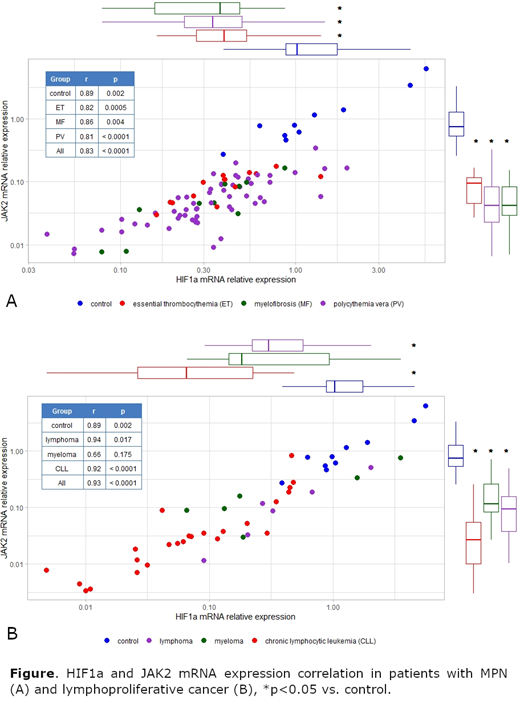Background. The hypoxia inducible factor 1a (HIF1a) is an important transcription factor regulating gene expression for an adaptive response to low oxygen level in human cells. Earlier, we observed a decrease of HIF1a and CALR mRNA, but not MPL expression in whole blood samples of patients with Ph-negative myeloproliferative neoplasm (MPN) compared with healthy volunteers (Gorbenko A., et al., Haematologica, 2017; Gorbenko A., et al., Blood, 2016). Recent transcriptome studies in granulocytes and CD34+ blood cells from MPN patients confirmed a decrease of mRNA CALR, but also revealed an increase of the relative mRNA level of HIF1a and JAK2 (Cokic VP, et al., PLoS ONE, 2015). These changes in the regulation of number genes expression may depend on the mutation JAK2V617F as was also shown (Berkofsky-Fessler W, et al., Clin Cancer Res. 2010). But some studies demonstrated transcriptomes data of the isolated blood cells from patients with lymphoproliferative disease did not find significant changes in the expression of these genes (Liao W, et al., BMC Cancer, 2015).
Aims. Investigate HIF1a, CALR and JAK2 mRNA expression in patients with lymphoproliferative and myeloproliferative cancer.
Methods. 10 healthy volunteers (average age 42 years, range 20-63 years, 80% of men) and 80 (average age 54 years, range 30-83 years, 46% of man), patients with MPN, also 36 (average age 62 years, range 28-79 years, 78% of man) patients with lymphoproliferative cancer after signing an informed consent were included in this study. In our study, we investigated the expression level of mRNA genes in whole blood samples obtained in test tubes with an RNA stabilizer (LTD "Formula of gene", Russia) in order to exclude the factors of preanalytical cell hypoxia. Quantitative real-time PCR was performed to determine the levels of HIF1a, CALR and JAK2 mRNA transcripts using TaqMan probes on the CFX96 (Bio-Rad). The results were calculated by ΔCt method in the software package of "R". The threshold cycles (Ct) genes and housekeeping genes (TBP, GUS, ABL) was determined using Cy0 method. The results were normalized by these reference genes. Mann-Whitney U-test was used to evaluate significance of differences between the groups, the degree of correlation (r) was assessed using Spearman test.
Results. We observed that HIF1a and JAK2 mRNA expression was significantly lower in whole blood samples of all patients with MPN and lymphoproliferative cancer compared with a group of healthy volunteers (p<0,001) (Figure). We discovered a strong correlation between JAK2 and HIF1a expression in all myeloproliferative and lymphoproliferative neoplasms (r=0.83 and r=0.93 respectively, p<0,001) (Figure). It should be noted that the correlation in the blood samples of patients with MPN was observed only when the total expression of wild and mutated transcripts JAK2 (JAK2+JAK2 V617F) was assessed. No correlation was found between the level of mRNA expression and the cellular number of granulocytes or lymphocytes. The expression level of CALR mRNA also decreases in the blood cells of MPN and lymphoproliferative cancer patients (p<0.05), but we did not observe its correlation with HIF1a or JAK2 mRNA.
Conclusion. We assume that the studied gene expression changes reflect the regulated metabolic processes in the cancer stem cells. Probably, the activation of the associated signaling pathways HIF1a and JAK2/STAT in the white blood cells of patients with chronic blood cancer leads to the adoptive enhancement of autophagy, causing a chronic course of the disease. The assume that the opposite shifts of HIF1a and JAK2 in the microarray research (Cokic VP, et al., PLoS ONE, 2015) can be associated with the procedure of blood cells isolation and the absence of a group of healthy people as a control. Reduced expression of CALR mRNA in patient blood cells requires further investigation.
No relevant conflicts of interest to declare.
Author notes
Asterisk with author names denotes non-ASH members.


This feature is available to Subscribers Only
Sign In or Create an Account Close Modal